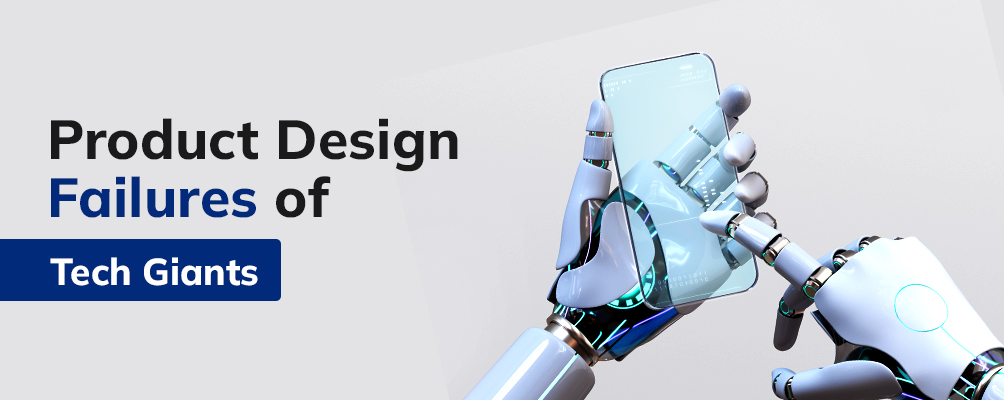
Product designing can be nerve-wracking for the challenges it brings. How well you approach users’ problems and the value you bring to the table decides the market competition for your product. A wrong idea can plummet down sales for your brand, so you need to watch out for the risks involved.
We will talk about some famous product design failures and why they failed:
Google Glass
The device stirred up the market with its appearance in 2012. It was seen as the future of AI, in which users could command the device and get relevant information displayed on the glass screen. However, people were unwilling to overlook the flaws. There were many health and safety concerns, which made Google Glass a miserable failure.
- People could exploit Google Glass to intervene someone’s privacy. The device could take photos and videos of people without prior information.
- Carcinogenic radiation from the device was harmful and one could only use it when kept in contact with the forehead. Prolonged exposure to carcinogenic radiation could cause skin cancer.
- The device was unappealing and felt more like a prototype than a final product.
Facebook Home
Facebook Home was released in 2013, and could change the entire look and feel of its users’ phones. It acted like a Facebook wrapper on a phone’s home screen, displaying status updates and photos from friends. A user could like the content they wished from their home screen. Within a month of launch, the Facebook Home saw a dip in popularity index. The reasons were:
- An app that continuously displayed status updates and photos was a distraction.
- It consumed heavy data to show updates.
- Facebook Home hid other apps with its menu beneath.
- It was compatible with only a handful of devices.
Although it had over a million downloads, Facebook Home could only procure 2-star ratings and a trail of negative reviews.
Microsoft Zune
Microsoft Zune, a 2006 competitor of iPod, was a big failure because it entered the market late, yet didn’t deploy any new features. The product could have drawn more attention if it addressed the downsides of the iPod. Instead, Zune only stood as a similar product in the market with nothing innovative, hence short-lived. The reasons why it failed were:
- No feature set it apart from iPod.
- Users already placed their trust in iPod, and without any new feature, Zune couldn’t broaden user preferences. A wider perception developed that Zune was not a good product when compared with iPod.
- It was not marketed to a broader audience and failed to draw attention.
Apple Newton
Apple Newton’s killer feature was to recognise handwriting besides taking notes, storing contacts, and managing calendars. While we only remember the products that captured the attention of the masses, there were innovations by Apple that failed, and Newton was one of them. Steve Jobs himself hated the product for its low performance. The reasons why the product’s sale couldn’t take off were:
- As the news of the product launch spread, competitive devices were planned, which shortened the timeline for Newton’s launch and Apple launched an incomplete product.
- It only offered 140kb of storage, which could be expanded with 1MB, 2MB, and 4MB flashcards.
- The device had handwriting recognition as its main feature, which worked poorly.
- Despite the bugs, the device models were not affordable. The senior model cost $5000, a mid-size model cost $2000 approx., and the junior cost $500.
As the experience was not so promising, the sales for Newton bombed.
Key takeaways for product designers from the failures of tech giants
- A product should resolve users’ problems and not complicate their lives posing health and security risks.
- Unappealing product designs fail to attract users in the long run. Even if the design is minimalistic, it should not look like a prototype that still needs to evolve.
- A product must serve a purpose or solve a problem, such as providing knowledge, counselling, entertaining, building a skill, meeting a daily requirement, etc. However, it should not become a distraction or hindrance for performing the other essential tasks. Users should be in control of when they want to use a product.
- In this growing digital age, products must be created for diverse audiences and not limited to a few.
- You can only shift users’ interest in your product when it is unique. A copy of an existing idea with no novel features cannot help you build consumer trust.
- Product planning is crucial to undergo multiple user tests before launching. A rushed process may lead to a faulty product with bugs, which will take down the sales sooner than you expect.
- Consumers are willing to pay more for a trusted brand, however, the product should fulfil the promises. Else, you might have to kill off the product line.
A skilled product designer understands such challenges and helps design a practical product that users like. Every product that has made its success in the market involved critical thinking keeping the end-user in mind.
No Comments